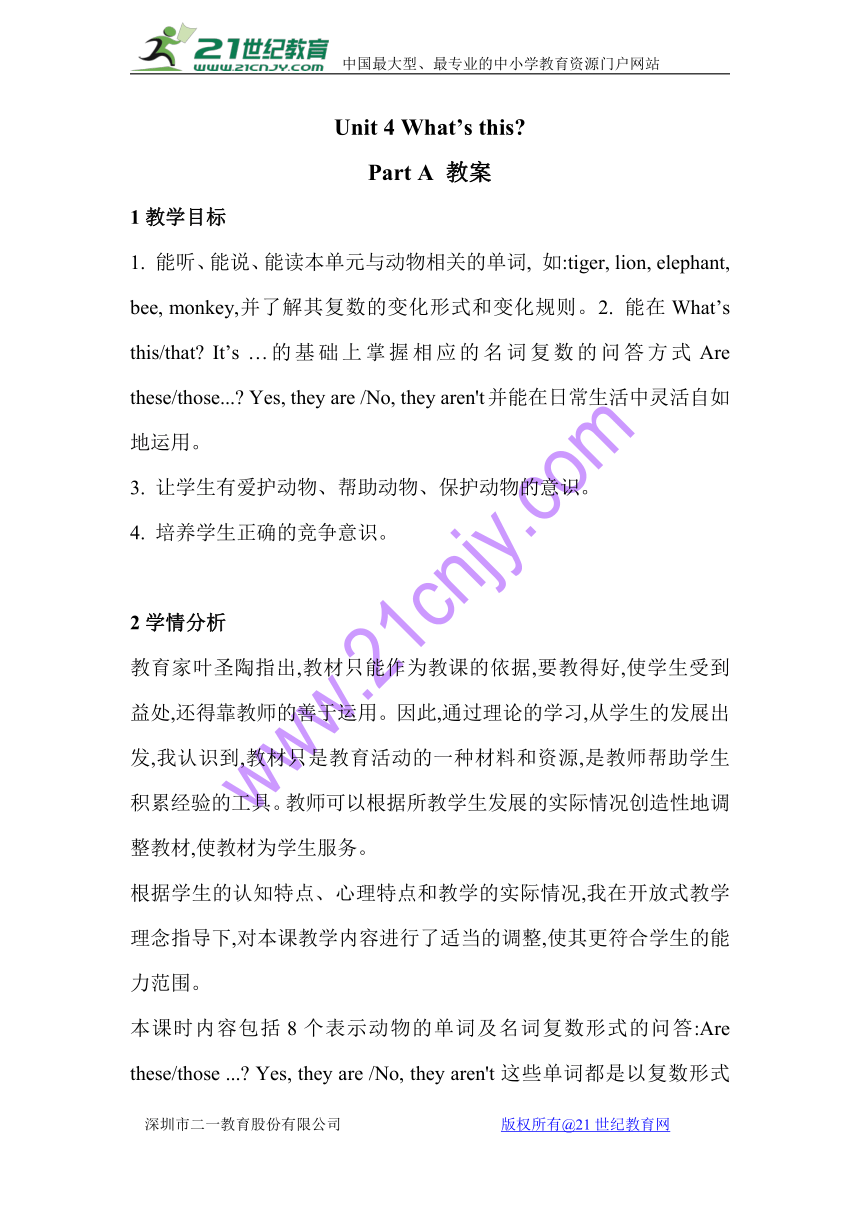Unit 4 What’s this? PA 教案
文档属性
| 名称 | Unit 4 What’s this? PA 教案 |  | |
| 格式 | zip | ||
| 文件大小 | 119.7KB | ||
| 资源类型 | 教案 | ||
| 版本资源 | 陕旅版 | ||
| 科目 | 英语 | ||
| 更新时间 | 2017-07-03 20:24:12 | ||
图片预览



文档简介
Unit 4 What’s this?
Part A 教案
1教学目标
1. 能听、能说、能读本单元与动物相关的单词, 如:tiger, lion, elephant, bee, monkey,并了解其复数的变化形式和变化规则。2. 能在What’s this/that? It’s …的基础上掌握相应的名词复数的问答方式Are these/those...? Yes, they are /No, they aren't并能在日常生活中灵活自如地运用。21·世纪*教育网
3. 让学生有爱护动物、帮助动物、保护动物的意识。
4. 培养学生正确的竞争意识。
2学情分析
教育家叶圣陶指出,教材只能作为教课的依据,要教得好,使学生受到益处,还得靠教师的善于运用。因此,通过理论的学习,从学生的发展出发,我认识到,教材只是教育活动的一种材料和资源,是教师帮助学生积累经验的工具。教师可以根据所教学生发展的实际情况创造性地调整教材,使教材为学生服务。2-1-c-n-j-y
根据学生的认知特点、心理特点和教学的实际情况,我在开放式教学理念指导下,对本课教学内容进行了适当的调整,使其更符合学生的能力范围。【来源:21cnj*y.co*m】
本课时内容包括8个表示动物的单词及名词复数形式的问答:Are these/those ...? Yes, they are /No, they aren't这些单词都是以复数形式出现的,我考虑到内容的量过多,不利于学生的有效学习。针对这一现状,我在本课时内抽出了ants, bears and chicks这三个单词,将其放入第二课时进行教学,降低难度,希望能适应学生的潜在水平,能促使学生更好地发展英语能力,能引导学生更有效地学习。【出处:21教育名师】
3重点难点
教学重点:
1. 熟练掌握新单词:tigers, lions, elephants, bees, monkeys
2. 名词复数的问答方式What are these/those? They are …
教学难点:
名词复数的问答方式What are these/those? They are …
4教学过程
活动1【导入】1.Warming-up
1. 将全班学生分成五组进行比赛。
[设计意图]通过比赛的形式培养学生的团队竞争意识。
2. Greetings.
3. Chant. (带动作)
Hello, Colin. What’s this?
It’s a dog. It’s a dog.
Hello, Colin. What’s that?
It’s a cat. It’s a cat.
Hello, Colin. What’s this?
It’s a lion. It’s a lion.
Hello, Colin. What’s that?
It’s a tiger. It’s a tiger.
[设计意图]通过Chant吸引学生的注意力,营造学习英语的氛围,还复习了有关动物的单词。
活动2【讲授】2.Lead-in
Enjoy the video: Animal World
T: (Enjoy) Do you like animals? Draw your favourite animals?
Ss: Yes.
T: In this class, let’s draw about them.
[设计意图]以其声情并茂的情境将抽象、枯燥、呆板的语言文字变得直观、形象、明了、清晰.通过画画使语言的功能在动态的画面中得到充分的体现,更能传达教学的意图。21·cn·jy·com
活动3【活动】3.Presentation
CAI shows the voice of the tiger.
T: Listen, what’s this?
Ss: It’s a tiger.
T: Yes, it’s a tiger. (CAI shows a tiger.) Now, look again. How many tigers are there? Let’s count with me. (CAI shows three tigers.)
(1)Learn to say.(带动作)
(2)Listen to the tape.
(3)Practice in groups.(给读得好的发奖品)
(4)Show the pictures of tigers to ask: What are these? Are these tigers? (引导学生作答)Yes, they are. They are tigers.(同时板书句子,tigers中的“s” in red,并将图片贴到黑板上)Spell the tigers.老师离讲台远一点问:What are those? Are these tigers? (引导学生作答)Yes, they are. They are tigers.(师出示句子中文或由学生说出)www-2-1-cnjy-com
(5)拿老虎头饰给几个孩子带上,操练What are these/those?
[设计意图]在学习中,让学生听老虎的声音,模仿老虎的动作,能把学生从无意注意引向有意注意,让学生在学习新单词时不会觉得枯燥,且能充分调动学生学习的积极性。21*cnjy*com
CAI shows a lion.
T: What’s that?
S: It’s a lion.
T: Look again. How many lions are there?
(1)Learn to say. (带动作)
(2)Listen to the tape.
(3)Practice in pairs. (击掌)
(4)Practice the sentences: Are these/those...? Yes, they are. They are….(卡片/头饰)www.21-cn-jy.com
3.CAI出示猴子的一部分.
T: Guess: What are these?
S:猴子。
T: They are monkeys.(出示整体)
(1)Learn to say.(带动作)
(2)Listen to the tape.
(3)Practice. (Big sound and small sound.)
(4)Practice the sentences: Are these/those ...? No they aren't, They are….(卡片/头饰)21世纪教育网版权所有
4.观看蜜蜂活动的一小段影片。
T: Listen and look, what are these?
S:熊猫。
T: They are bees.
(1)Learn to say.(带动作)
(2)Listen to the tape.
(3)Practice. (师生互动)
(4)Practice the sentences: What are these/those? They are….(卡片/头饰)
5.CAI shows the voice of the elephants.
T: What are these?
S:大象。
T: They are elephants.
(1)Learn to say. (带动作)
(2)Listen to the tape.
(3)Practice. (吹气球)
(4)Practice the sentences: What are these/those? They are….(卡片/头饰)
说明:tigers, lions, monkeys, bees and elephants中的后缀“s”都是用红色标出的。21教育网
[设计意图]采用不同的方法呈现新单词,运用不同的形式操练新单词和句型,能使学生进入良好的学习状态,激发学生的学习兴趣和求知欲望。2·1·c·n·j·y
在板书中对复数后缀用红色加以强调,以便于学生发现和总结,使其明白英语中名词复数的表达方式。
6.Open the books, and then read after the tape in groups.
[设计意图]让每一个孩子都动起来,让他们尝试成功的喜悦。.
7. Let's sing
活动4【活动】4.Practice&Extension
Let's learn
2. Play finger-guessing game. (Words)
3.快乐传真。(Sentences)
(1)Are these/those...? Yes, Yes, they are/No, they aren't They are keys /books /pens /desks /rulers. (实物)21cnjy.com
(2)What are these/those? They are tigers /lions /elephants /bees /monkeys. (CAI快速闪现这几种动物的图片)【来源:21·世纪·教育·网】
[设计意图]教学在游戏中进行,知识在游戏中延伸,游戏既能活跃课堂气氛,又避免了机械操练,还能增强学生对语言的理解。
活动5【练习】5.Let`s read
1. Read and understand.
2.四人一小组对话
活动6【活动】6.Summary
Animals are our friends, we should love, help and protect them.
Part A 教案
1教学目标
1. 能听、能说、能读本单元与动物相关的单词, 如:tiger, lion, elephant, bee, monkey,并了解其复数的变化形式和变化规则。2. 能在What’s this/that? It’s …的基础上掌握相应的名词复数的问答方式Are these/those...? Yes, they are /No, they aren't并能在日常生活中灵活自如地运用。21·世纪*教育网
3. 让学生有爱护动物、帮助动物、保护动物的意识。
4. 培养学生正确的竞争意识。
2学情分析
教育家叶圣陶指出,教材只能作为教课的依据,要教得好,使学生受到益处,还得靠教师的善于运用。因此,通过理论的学习,从学生的发展出发,我认识到,教材只是教育活动的一种材料和资源,是教师帮助学生积累经验的工具。教师可以根据所教学生发展的实际情况创造性地调整教材,使教材为学生服务。2-1-c-n-j-y
根据学生的认知特点、心理特点和教学的实际情况,我在开放式教学理念指导下,对本课教学内容进行了适当的调整,使其更符合学生的能力范围。【来源:21cnj*y.co*m】
本课时内容包括8个表示动物的单词及名词复数形式的问答:Are these/those ...? Yes, they are /No, they aren't这些单词都是以复数形式出现的,我考虑到内容的量过多,不利于学生的有效学习。针对这一现状,我在本课时内抽出了ants, bears and chicks这三个单词,将其放入第二课时进行教学,降低难度,希望能适应学生的潜在水平,能促使学生更好地发展英语能力,能引导学生更有效地学习。【出处:21教育名师】
3重点难点
教学重点:
1. 熟练掌握新单词:tigers, lions, elephants, bees, monkeys
2. 名词复数的问答方式What are these/those? They are …
教学难点:
名词复数的问答方式What are these/those? They are …
4教学过程
活动1【导入】1.Warming-up
1. 将全班学生分成五组进行比赛。
[设计意图]通过比赛的形式培养学生的团队竞争意识。
2. Greetings.
3. Chant. (带动作)
Hello, Colin. What’s this?
It’s a dog. It’s a dog.
Hello, Colin. What’s that?
It’s a cat. It’s a cat.
Hello, Colin. What’s this?
It’s a lion. It’s a lion.
Hello, Colin. What’s that?
It’s a tiger. It’s a tiger.
[设计意图]通过Chant吸引学生的注意力,营造学习英语的氛围,还复习了有关动物的单词。
活动2【讲授】2.Lead-in
Enjoy the video: Animal World
T: (Enjoy) Do you like animals? Draw your favourite animals?
Ss: Yes.
T: In this class, let’s draw about them.
[设计意图]以其声情并茂的情境将抽象、枯燥、呆板的语言文字变得直观、形象、明了、清晰.通过画画使语言的功能在动态的画面中得到充分的体现,更能传达教学的意图。21·cn·jy·com
活动3【活动】3.Presentation
CAI shows the voice of the tiger.
T: Listen, what’s this?
Ss: It’s a tiger.
T: Yes, it’s a tiger. (CAI shows a tiger.) Now, look again. How many tigers are there? Let’s count with me. (CAI shows three tigers.)
(1)Learn to say.(带动作)
(2)Listen to the tape.
(3)Practice in groups.(给读得好的发奖品)
(4)Show the pictures of tigers to ask: What are these? Are these tigers? (引导学生作答)Yes, they are. They are tigers.(同时板书句子,tigers中的“s” in red,并将图片贴到黑板上)Spell the tigers.老师离讲台远一点问:What are those? Are these tigers? (引导学生作答)Yes, they are. They are tigers.(师出示句子中文或由学生说出)www-2-1-cnjy-com
(5)拿老虎头饰给几个孩子带上,操练What are these/those?
[设计意图]在学习中,让学生听老虎的声音,模仿老虎的动作,能把学生从无意注意引向有意注意,让学生在学习新单词时不会觉得枯燥,且能充分调动学生学习的积极性。21*cnjy*com
CAI shows a lion.
T: What’s that?
S: It’s a lion.
T: Look again. How many lions are there?
(1)Learn to say. (带动作)
(2)Listen to the tape.
(3)Practice in pairs. (击掌)
(4)Practice the sentences: Are these/those...? Yes, they are. They are….(卡片/头饰)www.21-cn-jy.com
3.CAI出示猴子的一部分.
T: Guess: What are these?
S:猴子。
T: They are monkeys.(出示整体)
(1)Learn to say.(带动作)
(2)Listen to the tape.
(3)Practice. (Big sound and small sound.)
(4)Practice the sentences: Are these/those ...? No they aren't, They are….(卡片/头饰)21世纪教育网版权所有
4.观看蜜蜂活动的一小段影片。
T: Listen and look, what are these?
S:熊猫。
T: They are bees.
(1)Learn to say.(带动作)
(2)Listen to the tape.
(3)Practice. (师生互动)
(4)Practice the sentences: What are these/those? They are….(卡片/头饰)
5.CAI shows the voice of the elephants.
T: What are these?
S:大象。
T: They are elephants.
(1)Learn to say. (带动作)
(2)Listen to the tape.
(3)Practice. (吹气球)
(4)Practice the sentences: What are these/those? They are….(卡片/头饰)
说明:tigers, lions, monkeys, bees and elephants中的后缀“s”都是用红色标出的。21教育网
[设计意图]采用不同的方法呈现新单词,运用不同的形式操练新单词和句型,能使学生进入良好的学习状态,激发学生的学习兴趣和求知欲望。2·1·c·n·j·y
在板书中对复数后缀用红色加以强调,以便于学生发现和总结,使其明白英语中名词复数的表达方式。
6.Open the books, and then read after the tape in groups.
[设计意图]让每一个孩子都动起来,让他们尝试成功的喜悦。.
7. Let's sing
活动4【活动】4.Practice&Extension
Let's learn
2. Play finger-guessing game. (Words)
3.快乐传真。(Sentences)
(1)Are these/those...? Yes, Yes, they are/No, they aren't They are keys /books /pens /desks /rulers. (实物)21cnjy.com
(2)What are these/those? They are tigers /lions /elephants /bees /monkeys. (CAI快速闪现这几种动物的图片)【来源:21·世纪·教育·网】
[设计意图]教学在游戏中进行,知识在游戏中延伸,游戏既能活跃课堂气氛,又避免了机械操练,还能增强学生对语言的理解。
活动5【练习】5.Let`s read
1. Read and understand.
2.四人一小组对话
活动6【活动】6.Summary
Animals are our friends, we should love, help and protect them.
